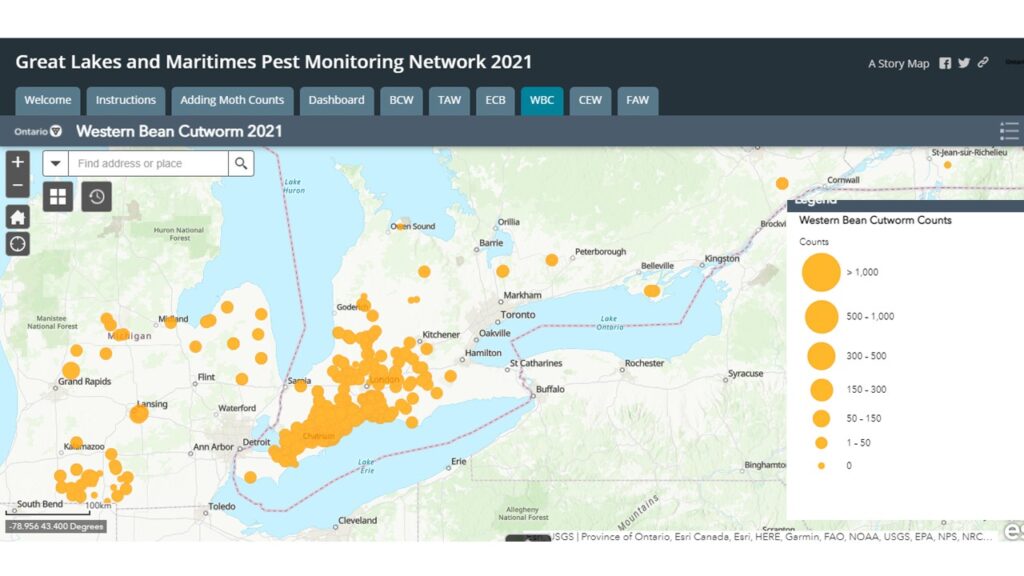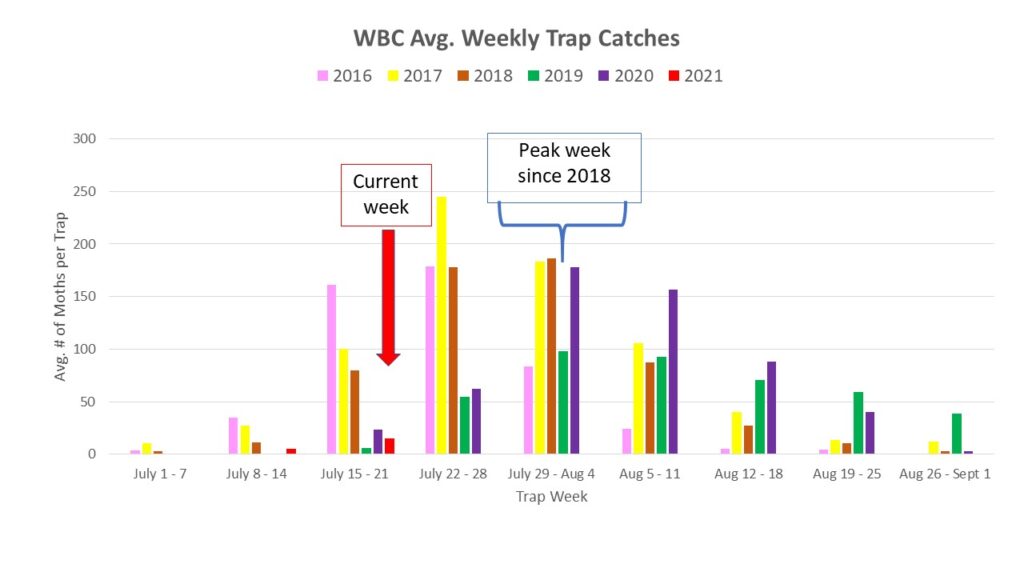Western bean cutworm traps catches are starting to increase but are still low compared to previous years with more weeks of moth flight (and egg laying) to come. Those finding eggs in early tassel stage need to wait before spraying since eggs are still going to be laid for another few weeks. It is better to time applications when the corn is in full silk but not already in brown silk. This will target as many of the larvae that come from the next few weeks of increased egg laying.
You can see the latest GLMPMN map for WBC trap catches below and at this link. https://ontarioca11.maps.arcgis.com/apps/MapSeries/index.html?appid=4f19db5a8c3547f397825be8a07e80fa
Just click on the “WBC” tab at the top of the GLMPMN site to see the map and zoom into your region or click on the “Dashboard” tab and select western bean cutworm as the pest to see the graphs for the trap data. You can then zoom in and out of the map and see the graphs change to analyze traps in the area where the map is zoomed into.

Comparing average trap catches this week with this same week in past years, we have some weeks of moth flight to go still. 2021 is in red and very low compared to past years. Peak flight since 2018 has been during the last week of July. So there is still more egg laying to come.

Scout the most advanced corn fields first. Look at all leaves from the ear up to the tassel. Take note of whether the eggs are fresh (white) or close to hatching (purple). Scout every 5 days so you can see how these egg masses are progressing. Also inspect the tassel for any tiny larvae that are feeding there. If after 3 scouting trips, 5% of the plants in the field have had eggs, threshold has been reached.
With peak flight not for another couple of weeks, insecticide applications this week are likely premature. Especially in fields that are just starting to tassel. It takes 5-7 days for eggs to hatch. The young larvae then move to the tassel to feed for a few days before moving down to the ear. It is better to time the application as close to FULL SILK but not brown silk to target larvae from next week or more of egg laying. This timing also lines up well with tankmixing with fungicides for ear mould protection. We need to be realistic too. No insecticide application is going to provide 100% control, especially when there is a long period of egg laying. One time applications need to be timed to get as many larvae as it can. Spraying when egg masses are just started to be deposited with more weeks of egg laying to come is not good timing.
In the Great Lakes Region, WBC is not a yield robber. They tend to only feed on the kernels at the ear tips which weren’t going to yield much anyway. Their real impact is from the wounds they create which increase ear mould risk. In years when weather conditions for ear mould development is low, their feeding injury is less of a concern. But in years when weather conditions are ideal for ear mould development, like they are for 2021, timing fungicide and insecticide applications is important. Hitting fresh silks with insecticide and fungicide provides the best protection possible.
Don’t rely on the same management practice every year for this pest. That includes rotating VIP3A hybrids with insecticide products annually to help reduce the risk of resistance. Also rotate which insecticidal products you use to also reduce the risk of resistance. I know many like one product in particular and use it year after year but we risk losing that product due to resistance development. Products registered for WBC control on corn are available in Publication 812.
Dry bean growers still have some time to go before needing to worry about management. Applications are best timed after peak flight which we are still a few weeks away from. So stayed tuned.